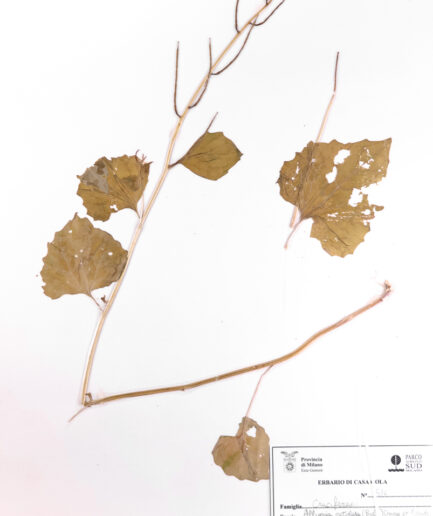Red bryony
Scientific name: Bryonia dioica Jacq.
Family: Cucurbitaceae
MORPHOLOGY
Habit and dimensions: Perennial, dioecious, herbaceous, climbing plant, deciduous, with a large, fleshy, white internally and milky when cut, yellowish-barked taproot. Stem length can reach up to 3-4 m.
Stem: Herbaceous, fragile, prickly, twining stems, equipped with non-branching tendrils that allow the plant to cling to any support.
Leaves: Pedunculate, alternate, palmately-lobed with acute apex and cordate base, divided into 5 lobes up to the middle, opaque green in color, rough to the touch due to scattered stiff hairs, palmately veined, without stipules, the margin is entire with blunt teeth, reaching up to 10 cm in length.
Flowers: Male inflorescences are glandular, pedunculate, while female ones are almost sessile in the axil of the leaves. The calyx is tubular, divided into 5 lobes, calyx teeth are about half the length of the corolla. The flowers are unisexual, actinomorphic, pentamerous, tubular, glandular; the perianth is gamopetalous, yellowish-white streaked with green. Male flowers are about twice as long as female ones. It blooms between March and June.
Fruits and seeds: The fruits are globose berries, smooth, initially greenish-yellow, maturing to scarlet red, containing multiple dark-colored seeds.
DISTRIBUTION AND HABITAT
Widespread throughout Italy except for Sardinia. Thrives from 0 to 1,000 m altitude in ruderal environments, thickets, hedges at the edge of woods.
USE
Bitter herb, purgative, diuretic, rubefacient, and antirheumatic. Formerly used in medicine, in small doses, for bronchial diseases, asthma, intestinal ulcers, hypertension, and arthritis. Externally used for muscular and joint pain and as a rubefacient. Bryonia wine, obtained by macerating the roots in white wine, was considered a good diuretic and vermifuge. The entire plant is highly toxic; ingestion of the berries causes mouth burning, vomiting, delirium, central nervous system paralysis, and death. Even the ingestion of a few berries can be fatal for children, while the plant sap in contact with the epidermis causes inflammation with blistering. Today, due to its high toxicity, it is no longer used internally and is also not recommended for topical use. In veterinary medicine, however, the homeopathic remedy obtained from the fresh root of Bryonia cretica is one of the most important remedies for polyarthritis when it has a predominantly acute muscular origin. Before taking any plant-based product (medicinal or non-medicinal) for therapeutic or similar purposes, it is always advisable to consult a doctor.
INTERESTING FACTS
The large root, also known as “English mandrake,” was traditionally hung in herbalist shops, often accompanied by the silhouette of a man to resemble the true Mandrake (Mandragora officinarum). The root of this species can reach considerable sizes; as mentioned by N. Culpeper in The English Physitian Enlarged, 1653, “The queen’s chief surgeon showed me a root of this plant as large as a one-year-old child.”
Photo: Used under free license from Saxifraga, Ed Stikvoort, Willem van Kruijsbergen, Marijke Verhagen, Rutger Barendse.























